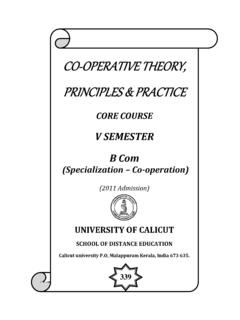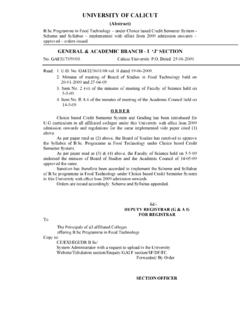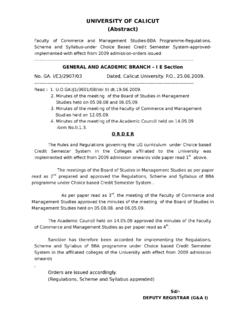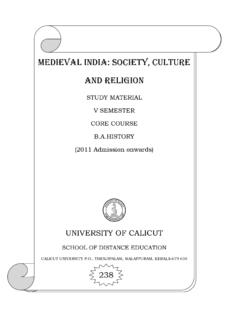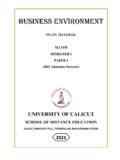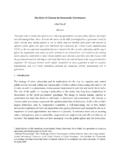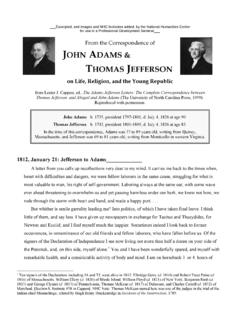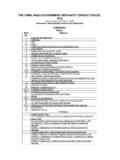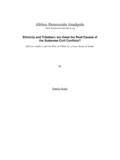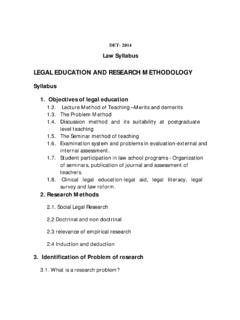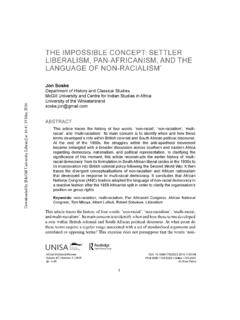Transcription of INDIAN CONSTITUTION AND POLITICS QUESTION …
1 School of Distance Education UNIVERSITY OF CALICUT. SCHOOL OF DISTANCE EDUCATION. II SEMESTER. COMPLEMENTARY COURSE. INDIAN CONSTITUTION AND POLITICS . QUESTION BANK. (1) The Union List consists of (a) 97 subjects (b) 61 subjects (c) 47 subjects (d) 73 subjects (2) An interpretation of the CONSTITUTION of India is based on the spirit of (a) Fundamental Duties (b) Fundamental Rights (c) Preamble (d) Federal System (3) The Constituent Assembly was set according to the proposals of (a) The Cripps Mission (b) the Cabinet Mission (c) Mountbatten Plan (d) Rajagopalachari Plan (4)The Fundamental Duties in the CONSTITUTION of India were adopted from (a)Canadian CONSTITUTION (b) Russian CONSTITUTION (c) American CONSTITUTION (d) French CONSTITUTION (5)Which Article of the CONSTITUTION of India deals with the Fundamental Duties (a)
2 Article 32 (b) Article 50. (c) Article51 (d) Article 51 A. (6) In India Right to Property is a (a) Moral Right (b) Legal Right (c) Fundamental Right (d) Personal Right (7) Which article is referred to as the jewel of the CONSTITUTION '. (a) Article 352 (b) Article 123. (c) Article 32 (d) Article 31. (8) Which writ give the meaning we command' in letters (a) Habeas Corpus (b) Prohibition (c) Quo Warranto (d) Mandamus INDIAN CONSTITUTION and POLITICS Page 1. School of Distance Education (9) Which of the following is not included in the Fundamental Rights in the CONSTITUTION of India? (a) Right to adequate means of livelihood (b) Right to Freedom (c) Right against Exploitation (d) Right to Equality (10)The Directive Principles of State Policy have been adopted from (a) US CONSTITUTION (b) Irish CONSTITUTION (c) French CONSTITUTION (d) Canadian CONSTITUTION (11)Keshavananda Bharati case was associated with (a) Fundamental Rights (b) Directive Principles of State Policy (c) State right (d) Armed rebellion (12)The word socialist' was added to the Preamble of the CONSTITUTION of India by which amendment (a) 44th (b) 27th (c) 21st (d) 42nd (13) The CONSTITUTION of India is (a) Rigid (b) flexible (c) Combination of rigidity and flexibility (d)
3 Neither rigid nor flexible (14) Right to Freedom is guaranteed in which article (a) 17 (b) 19. (c) 18 (d) 20. (15) Directive Principles of State Policy is (a) Justifiable (b) non-justifiable (c) mandatory (d) None of these (16) The word secularism' was added to the Preamble of the CONSTITUTION of India by which amendment (a) 40th (b) 42nd (c) 44th (d) 46th (17)Right to Property is included in Article (a) 32 (b) 19. (c) 31 (d) 14. (18)Right to Property was removed from Fundamental Rights by which amendment (a) 29th (b) 25th (c) 44th (d) 42nd (19) Part IV A of the INDIAN CONSTITUTION deal with (a) Fundamental Duties (b) Fundamental Rights (c) Directive Principles of state Policy (d) Citizenship (20) The procedure for amending the CONSTITUTION of India is (a) Rigid (b) flexible (c) partly rigid and flexible (d) None of these INDIAN CONSTITUTION and POLITICS Page 2.
4 School of Distance Education (21)Elections to the local government bodies are made mandatory by which amendment (a) 72nd (b) 73rd (c) 64th (d) 63rd (22) Panchayath Raj is included in the (a) Union list (b) Concurrent list (c) State list (d) Residuary power (23)Village Panchayath is organized under which article of the CONSTITUTION of India (a) Article 37 (b) Article 38. (c) Article 39 (d) Article 40. (24) Among the following which agency conducts election to the local bodies (a) National Election Commission (b) State Election Commission (c) Local bodies themselves (d) the Government (25) The chairman of the National Development Council is the (a) Prime Minister (b) President (c) Vice President (d) Governor (26) Who appoints the chairman of the Finance Commission (a) The President (b) Prime Minister (c) Council of Ministers (d) Vice President (27) The members of the Council of states in India is elected for a period of (a) 4 years (b) 5 years (c) 6 years (d) life term (28) The President can't --------------------- Lok Sabha (a) Dissolve (b) adjourn (c)
5 Prorogue (d) summon (29) The duration of an ordinance issued by the President of India is (a) 6weeks (b) 1 year (c) 6 months (d) 6 weeks from the date of assembly of the Parliament (30) All speeches made in the House of People are addressed to (a) The Prime Minister (b) The Speaker (c) Minister for Parliamentary Affairs (d) Respective Ministers (31) Who promulgates ordinance in states (a) Governor (b) Chief Minister (c) President (d) Chief Justice (32)Who presides over the joint sitting of the Parliament (a) President (b) Vice President (c) Speaker (d) Chief Justice (33) The amending power of the CONSTITUTION of India is described in Article (a) 352 (b) 368 (c) 360 (d) 395.
6 INDIAN CONSTITUTION and POLITICS Page 3. School of Distance Education (34) The ex-officio chairman of the Council of states is (a) Speaker (b) Vice President (c) Deputy Speaker (d) Deputy Chairman (35)In India the Council of state is responsible to (a) The people (b) the state (c) local government (d) None of these (36) The number of the Anglo indians nominated to the House of People is (a) 4 (b) 3 (c) 2 (d) 1. (37) The number of nominated members to the council of states is (a) 18 (b) 12 (c) 20 (d) 16. (38)The number of elected members to the House of the People (a) 540 (b) 542 (c) 543 (d) 545. (39) Who is the person authorized to conduct the election of the speaker in a newly elected House of the People in India (a) Prime Minister (b) Speaker (c) Proterm speaker (d) Deputy Speaker (40)Who was the chairman of the CONSTITUTION Drafting Committee (a) Jawahar Lal Nehru (b) Dr Ambedkar (c) Dr Rajendra Prasad (d) Sardar Vallabhai Patel (41) How many methods are there to amend the CONSTITUTION of India (a) 5 (b) 4 (c) 3 (d) 2.
7 (42) Quo warranto is (a) Writ (b) statute (c) Treaty (d) Act (43) Article 352 of the INDIAN CONSTITUTION deal with (a) centre-state relations (b) Supreme Court (c) state emergency (d) national emergency (44) Which Right was remarked by Dr Ambedkar as the heart and soul of the CONSTITUTION . (a) Right to Equality (b) Right to Freedom (c) Right to Education (d) Right to Constitutional remedies (45) The INDIAN CONSTITUTION guarantees how many categories of Fundamental Rights (a) 5 (b) 6 (c) 7 (d) 8. (46)Which Constitutional amendment incorporated the Fundamental Duties in the CONSTITUTION of India? (a) 40th (b) 44th (c) 42nd (d) 50th (47)Right to property was deleted by which amendment (a) 71st (b) 44th (c) 42nd (d) 68th INDIAN CONSTITUTION and POLITICS Page 4.
8 School of Distance Education (48) Who said the Preamble is the key to the CONSTITUTION . (a) Dr Ambedkar (b) Dr Rajendra Prasad (c) Jawaharlal Nehru (d)C. Rajagopalachari (49) Article 19 of the CONSTITUTION of India contains (a) 9 Fundamental Freedoms (b) 8 Fundamental Freedoms (c) 7 Fundamental Freedoms (d) 6 Fundamental Freedoms (50)The Chairman of the National Human Rights Commission is appointed by (a) Prime Minister (b) President (c) Vice President (d) Council of Ministers (51)Which among the following is not a Fundamental Right? (a) Right to Equality (b) Right to Property (c) Right to Freedom (d) Right against exploitation (52)Rights given in the CONSTITUTION are called Fundamental Right because (a) They are natural rights (b) They can't be suspended (c) They are a part of the CONSTITUTION (d) They can be enforced and safeguarded by the courts (53) Article 32 stands suspended during an emergency under Article (a) 352 (b) 356 (c) 360 (d) 362.
9 (54) Right to privacy is contained in (a) Article 22 (b) Article 19. (c) Article 21 (d) Article 22. (55) Freedom of expression is included in the article (a) 15 (b) 19 (c) 21 (d) 22. (56)The emergency provisions of the CONSTITUTION of India have been borrowed from (a) German CONSTITUTION (b) American CONSTITUTION (c) French CONSTITUTION (d) Irish CONSTITUTION (57) Concurrent list was adopted from (a) Russian CONSTITUTION (b) American CONSTITUTION (c) Swiss CONSTITUTION (d) French CONSTITUTION (58)Equality before law and Equal protection of law have been modelled on the CONSTITUTION of (a) Britain (b) America (c) Russian (d) Switzerland (59)Which article of the CONSTITUTION of India empower the President to take over the administration of a state on the basis of failure of constitutional machinery (a) 365 (b) 352 (c) 356 (d) 360.
10 (60) In India the power of amnesty' has been given to the (a) President (b) Prime Minister (c) Chief of the army (d) Parliament INDIAN CONSTITUTION and POLITICS Page 5. School of Distance Education (61)The President's rule in a state can be continued at a stretch for a maximum period of (a) 4years (b) 2years (c) 3 years (d) one year (62) The Council of state in India has how many elected members (a) 250 (b) 238. (c) 245 (d) 230. (63) The executive power in India is actually exercised by (a)Speaker (b) President (c) Council of Ministers (d) Parliament (64) 42nd amendment Act was adopted by the Parliament in (a) 1967 (b) 1968. (c) 1976 (d) 1977. (65) The supreme commander of the armed forces in India is (a) President (b) Prime Minister (c) Defence Minister (d) None of these (66) Public Undertaking Committee is a (a)Cabinet Committee (b) Parliamentary Committee (c) Committee of a political party (d) None of these (67)What is the maximum gap permissible between two sessions of the Parliament?

